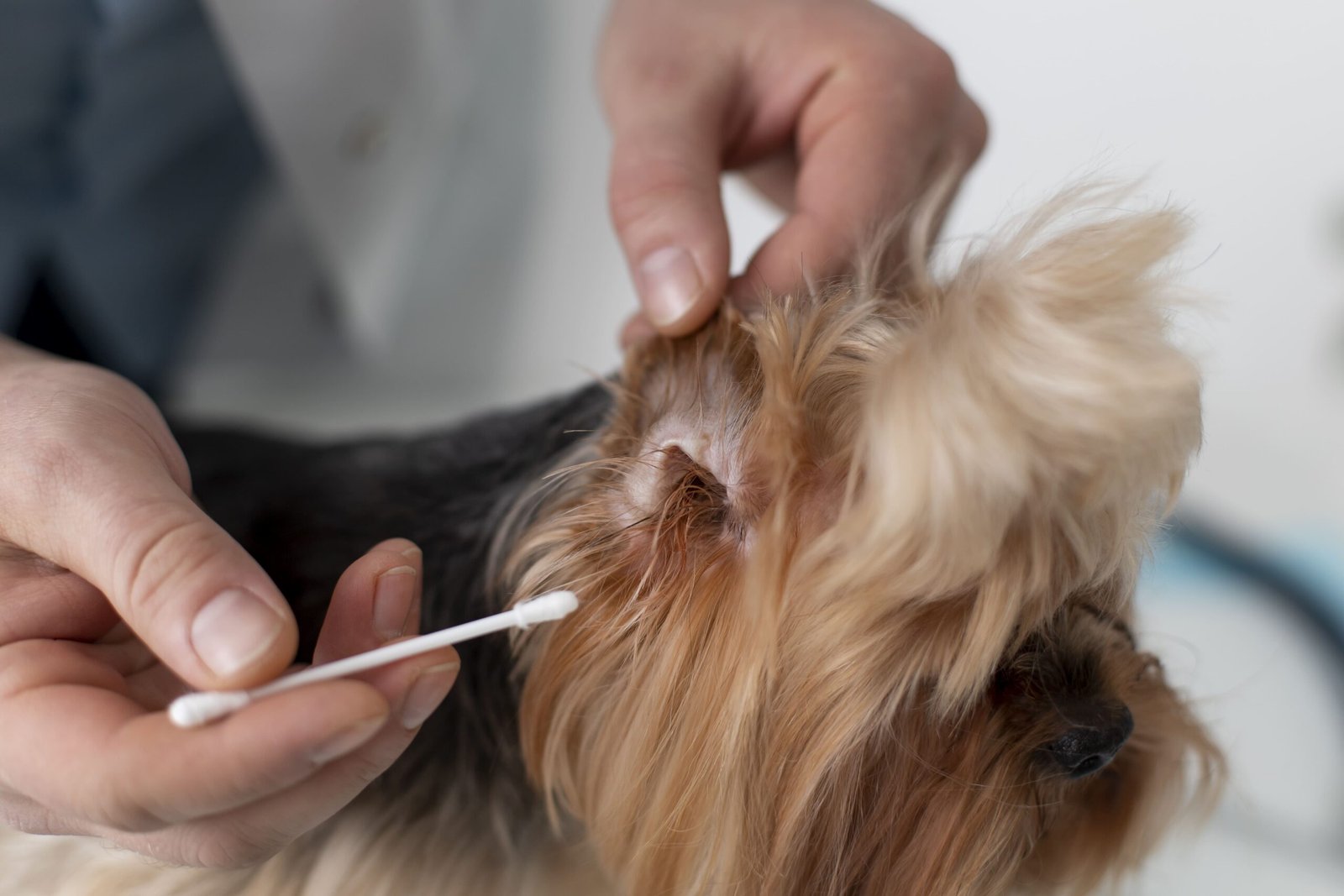
As pet parents, we adore our furry companions, lavishing them with cuddles, playtime, and the best nutrition. Yet, despite our best efforts, one of the most common and distressing issues pets face are skin infections. From relentless scratching to visible lesions, these conditions can cause significant discomfort and, if left untreated, lead to more severe health problems. The good news? Early detection and prompt treatment are key to a quick and full recovery.
This comprehensive guide will walk you through everything you need to know about pet skin infections, from identifying the various types and their causes to understanding treatment options and, most importantly, prevention strategies. We’ll equip you with the knowledge to recognize the signs and empower you to seek timely professional help, ensuring your beloved pet enjoys a healthy, itch-free life.
Decoding Pet Skin Infections: Types and Their Triggers
Pet skin problems aren’t a one-size-fits-all issue. They come in various forms, each with unique characteristics and underlying causes.
A. Bacterial Infections (Pyoderma): The Unwanted Invaders
Bacterial skin infections, collectively known as pyoderma, are incredibly common in pets. They often arise when the skin’s natural defenses are compromised, allowing bacteria (most commonly Staphylococcus species) to overgrow.
- Causes: Pyoderma often develops secondary to other issues like allergies (environmental or food), untreated wounds, or parasitic infestations that damage the skin barrier.
- Symptoms: Look out for tell-tale signs such as redness (erythema), pus-filled bumps (pustules), hair loss (alopecia), and crusty scabs.
- Common Types:
- Hot Spots (Acute Moist Dermatitis): Rapidly appearing, red, moist, and painful lesions often caused by excessive licking or chewing in response to an irritant.
- Impetigo: Superficial bacterial infection, typically seen in puppies, characterized by small, pus-filled blisters.
- Folliculitis: Inflammation of the hair follicles, leading to bumps, scabs, and hair loss, often mistaken for other skin conditions.
B. Fungal Infections: The Spreading Menace:
Fungal infections, while less common than bacterial ones, can be persistent and highly contagious.
- Causes: These infections are typically caused by exposure to fungal spores in the environment, thriving in moist conditions, or occurring in pets with weakened immune systems.
- Symptoms: You might notice circular lesions with hair loss, scaling, redness, and sometimes a distinctive musty odor.
- Common Types:
- Dermatophytosis (Ringworm): Despite its name, ringworm is a fungal infection, not a worm. It presents as circular patches of hair loss, scaling, and inflammation, and is highly contagious to other pets and humans.
- Yeast Infections (Malassezia Dermatitis): Caused by an overgrowth of the Malassezia yeast, which is naturally present on the skin. Symptoms include greasy skin, redness, scaling, and a strong, often pungent odor, particularly in skin folds or ears.
C. Parasitic Infestations: More Than Just an Itch:
Parasites don’t just cause itching; they can directly lead to skin infections or significantly weaken the skin’s defenses, paving the way for secondary bacterial or fungal issues.
- Flea Allergy Dermatitis (FAD): Even a single flea bite can trigger a severe allergic reaction in sensitive pets, leading to intense itching, redness, scabs, and secondary bacterial infections.
- Mites:
- Scabies (Sarcoptic Mange): Highly contagious mites that burrow into the skin, causing intense itching, redness, hair loss, and crusting.
- Demodex (Demodectic Mange): These mites are normally present on pet skin but can proliferate in puppies or immunocompromised adults, leading to localized or generalized hair loss, redness, and sometimes secondary bacterial infections.
- How Parasites Compromise the Skin Barrier: The constant scratching, biting, and burrowing associated with parasitic infestations create micro-abrasions and inflammation, disrupting the skin’s protective barrier and making it susceptible to opportunistic bacterial and fungal invaders.
Unraveling the Root Cause: Common Factors and Risk Factors:
Understanding why skin infections occur is crucial for effective treatment and prevention.
- Allergies: Environmental allergens (pollen, dust mites, mold) and food allergies are major culprits, causing chronic inflammation and itching, which leads to self-trauma and secondary infections.
- Parasites: As discussed, fleas, ticks, and mites are significant instigators of skin problems.
- Hormonal Imbalances: Conditions like hypothyroidism (underactive thyroid) or Cushing’s disease (overproduction of cortisol) can weaken the immune system and impair skin health, making pets more prone to infections.
- Poor Grooming/Hygiene: Infrequent bathing, matted fur, and uncleaned skin folds create warm, moist environments ideal for bacterial and yeast overgrowth.
- Weakened Immune System: Illness, stress, certain medications, or genetic predispositions can compromise a pet’s immune response, making them more vulnerable.
- Wounds, Scratches, and Trauma: Any break in the skin, no matter how small, can serve as an entry point for pathogens.
- Environmental Factors: High humidity, exposure to irritants (chemicals, harsh shampoos), or even prolonged moisture from swimming can contribute to skin issues.
Spotting the Signs: Symptoms to Watch For:
Vigilance is key. Early recognition of symptoms can make a significant difference in your pet’s recovery.
- Excessive scratching, licking, chewing: This is often the first and most obvious sign something is amiss.
- Redness, inflammation, rashes: Look for any abnormal discoloration or swelling of the skin.
- Hair loss (alopecia): Patches of missing fur can indicate an underlying skin problem.
- Scabs, crusts, scales: These are often signs of inflammation, infection, or parasitic activity.
- Pus or discharge: Any fluid oozing from the skin is a strong indicator of infection.
- Foul odor from the skin: A strong, unpleasant smell, especially from areas like ears or skin folds, often points to yeast or bacterial overgrowth.
- Bumps, pustules, or lesions: These can range from small pimples to larger, ulcerated areas.
- Changes in skin texture or color (hyperpigmentation): Chronically inflamed skin can become thickened and darkened (leathery).
The Vet’s Role: Accurate Diagnosis is Paramount:
If you notice any of these signs, a trip to your veterinarian is essential. Self-diagnosing and treating can often worsen the problem. Your vet will conduct a thorough examination and may recommend specific diagnostic tests:
- Physical examination: A detailed visual inspection of the skin and coat.
- Skin scrapings: Used to collect samples from the skin surface to identify mites under a microscope.
- Fungal cultures: Hair and skin samples are cultured in a lab to grow and identify fungal organisms like ringworm.
- Cytology: Microscopic examination of skin cells collected via tape impression or swab to identify bacteria, yeast, and inflammatory cells.
- Biopsy: In complex or non-responsive cases, a small tissue sample may be taken for histopathological examination.
- Allergy testing: If allergies are suspected as the underlying cause, intradermal skin testing or blood tests may be performed to identify specific allergens.
Effective Treatment Options for a Speedy Recovery:
Once a diagnosis is made, your veterinarian will develop a tailored treatment plan.
- Topical Treatments: Medicated shampoos, creams, sprays, and ointments are often prescribed for localized infections or as an adjunct to systemic therapy.
- Oral Medications:
- Antibiotics: For bacterial infections, often prescribed for several weeks to ensure complete eradication.
- Antifungals: To combat fungal infections like ringworm or yeast overgrowth.
- Antiparasitics: To eliminate fleas, ticks, or mites.
- Steroids: May be used short-term to reduce severe inflammation and itching.
- Addressing Underlying Causes: Treating the primary cause is crucial for long-term success. This might involve allergy management (dietary changes, antihistamines, immunotherapy), hormonal therapy, or managing other systemic illnesses.
- Pain Management and Anti-inflammatory Measures: Medications can be prescribed to alleviate discomfort and reduce inflammation, making your pet more comfortable during recovery.
- Importance of Completing the Full Course of Treatment: It’s vital to follow your vet’s instructions precisely and complete the entire course of medication, even if symptoms improve, to prevent recurrence and antibiotic resistance.
Prevention is Key: Keeping Skin Infections at Bay:
An ounce of prevention is worth a pound of cure, especially when it comes to pet skin health.
- Regular Grooming and Bathing: Brush your pet regularly to remove loose hair and dirt. Bathe them with appropriate pet-specific shampoos as recommended by your vet, especially if they have skin folds.
- Consistent Flea, Tick, and Mite Prevention: Use veterinarian-recommended year-round parasite control.
- Balanced Diet and Nutritional Supplements: A high-quality, balanced diet supports overall health and a strong immune system. Omega-3 fatty acids can be particularly beneficial for skin and coat health.
- Environmental Control: Regularly clean your pet’s bedding, vacuum frequently, and use air purifiers if environmental allergies are a concern. Identify and eliminate any household irritants.
- Stress Reduction: Stress can weaken the immune system. Provide a stable, enriching environment for your pet.
- Regular Veterinary Check-ups: Routine visits allow your vet to catch potential issues early and provide guidance on preventative care.
When to Seek Professional Help: Don’t Delay!
While some minor skin irritations might resolve on their own, it’s always best to err on the side of caution. Contact Royal Pets Veterinary Clinic in Abu Dhabi immediately if you notice:
- Persistent itching that doesn’t subside.
- Worsening symptoms despite home care.
- Open sores, pus, or foul-smelling discharge.
- Fever or lethargy accompanying skin changes.
- Any new or unusual skin changes that concern you.
Conclusion: A Healthy Pet Starts with Healthy Skin:
Pet skin problems can be a source of frustration for both pets and their owners, but with prompt action and proper care, most infections can be successfully treated. Recognizing the signs early, understanding the potential causes, and seeking professional veterinary advice are crucial steps in ensuring your pet’s comfort and well-being. Proactive prevention through good hygiene, nutrition, and parasite control will go a long way in maintaining their healthy skin and coat.
Don’t let your beloved companion suffer in silence! If you suspect your pet has a skin infection, don’t hesitate. Contact Royal Pets Veterinary Clinic in Abu Dhabi today to schedule a comprehensive examination. Our experienced team is dedicated to providing compassionate and effective care for your furry family members.
(FAQ):
Q1: Can I use human creams or medications on my pet’s skin infection? A1: No, absolutely not. Human medications can be toxic to pets, and what works for humans may not be appropriate or safe for animals. Always consult your veterinarian before applying any topical treatments or administering medications to your pet.
Q2: How long does it take for a pet skin infection to heal? A2: The healing time varies depending on the type and severity of the infection, as well as the underlying cause. Superficial infections might clear up in a few weeks, while deeper or chronic infections could take months to resolve. Consistency with the prescribed treatment plan is crucial for a successful outcome.
Q3: Are pet skin infections contagious to humans or other pets? A3: Some pet skin infections, like ringworm (a fungal infection) and sarcoptic mange (scabies), are zoonotic, meaning they can be transmitted to humans and other animals. It’s important to practice good hygiene and follow your vet’s advice to prevent spread.
Q4: What role does diet play in pet skin health? A4: A balanced and nutritious diet is fundamental for overall pet health, including skin and coat health. Deficiencies can lead to poor skin barrier function. In some cases, food allergies can be a direct cause of skin problems, necessitating a specialized diet. Omega-3 fatty acids are particularly beneficial for skin health.
Q5: My pet keeps getting recurring skin infections. What should I do? A5: Recurring skin infections often indicate an underlying issue that hasn’t been fully addressed. This could be allergies, hormonal imbalances, or a persistent immune system weakness. It’s crucial to work closely with your veterinarian to identify and manage the root cause to prevent future recurrences. Further diagnostic tests, such as allergy testing or endocrine panels, might be recommended.

